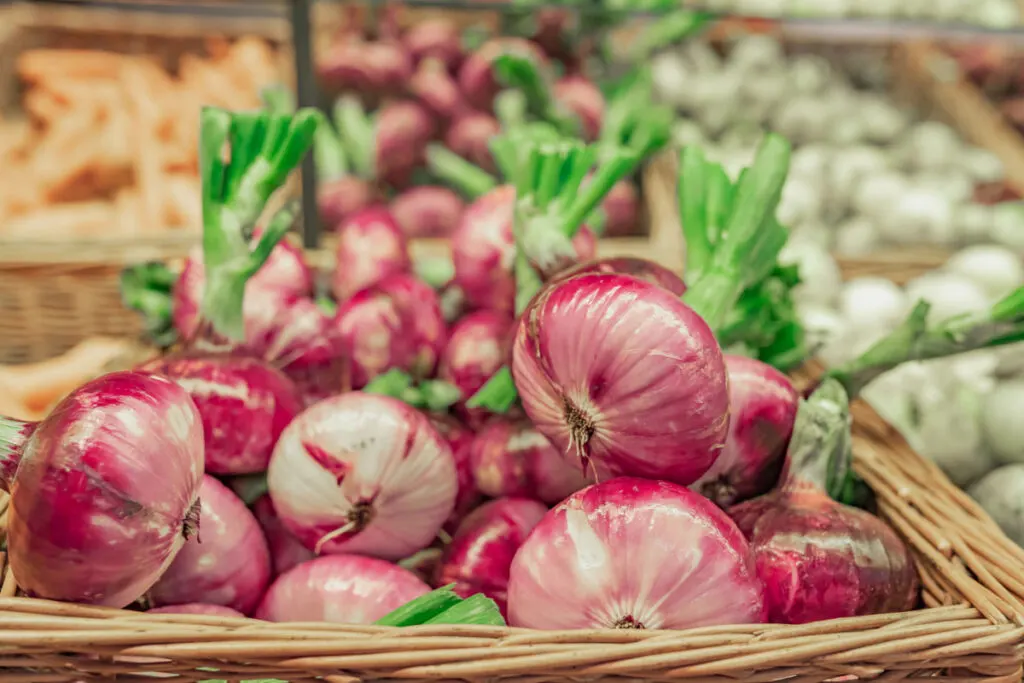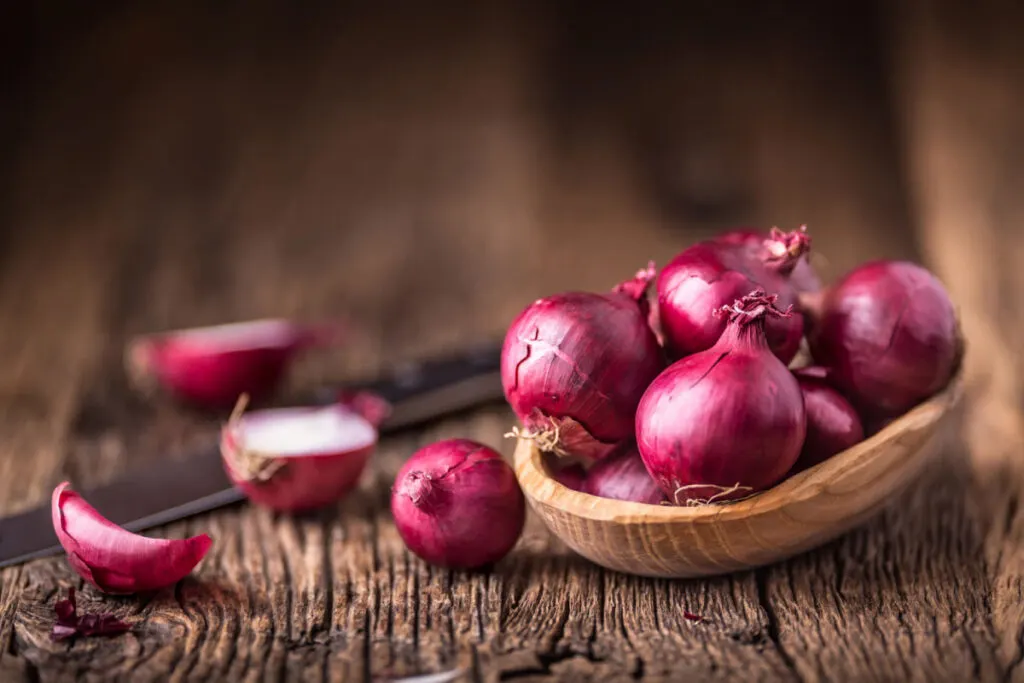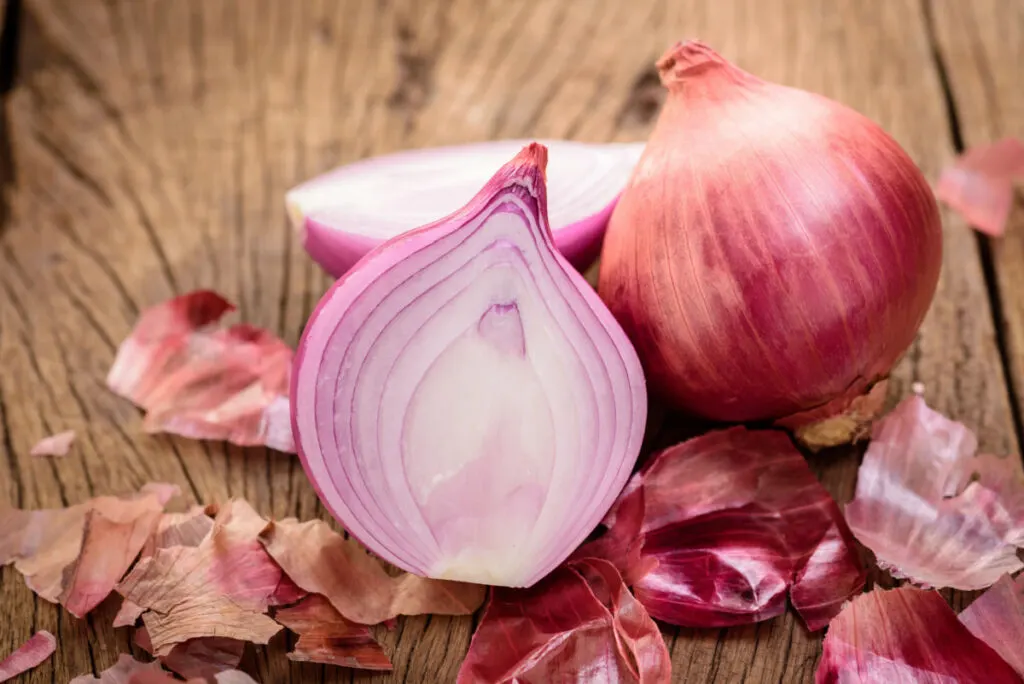We’ve all seen them in salads, in sandwiches, or confused them with radishes and beets. Onions are typically white or yellow, aren’t they?
But of course, just like the red panda and red velvet, there always has to be a red variety. Hence: the red onion.
Different onions have different purposes in the kitchen, and different foods will be enhanced with the help of a certain onion. Onions are texture and flavor-adding agents, but are not meant to be on their own as a side dish and especially not as a main course!
But even within the red onion, which has its own overall purpose, there are multiple types. Red onions are named for their “red” appearance, though really they are more purple than red. They are known to be the sweetest type of onion, which makes them perfect for adding to vegetable and fruit salads and as an added crunch and flavor to sandwiches.

Notice that, at sandwich shops such as Subway, Potbelly’s, and Firehouse Subs, when you add onions to your sandwich they are always red onions?
The coloring is mainly on the outside of the onion on the skin, but veins of the purplish-red run through the rings of the onion, so even when cut and without tasting it you can tell that a slice is from a red onion.
There are seven types of red onions, but typically when at a grocery store they are all piled into one bin and labeled “red onions.” However, within each type, there are specific sweetness levels, flavors, and uses.
Perhaps you are an aspiring cook, and you’d like to use red onion but you’d like even more to use the correct red onion for your particular dish to wow the judges and add a whole other element of flavor to your cooking.
Without further ado, read on to learn the seven types of red onions and what to use them for in cooking!
Table of Contents
1. Red Creole
Red Creole onions were found in 1962 in California. They are dark reddish-purple in color, spherical, and medium to large in size. They have large purple rings when cut into, although the purple rings bleed into the white rings slightly, giving an all-around purple color to the inside of the onion.
Red creole onions are moderately easy to grow and have adapted well to areas that experience shorter days than normal (as long as they get six hours of sunlight, they’re good).
They take about three and a half months to grow but can be stored for twice that time after harvest. They are a very tolerant plant and can resist drought and disease well.
These onions are one of the least sweet in the red onion family, opting for more of a spicy bite along with its tangy odor. They can be described with a Cajun-style flavor. They can be added to any type of dish for a much bolder flavor.
2. Red Baron Onions

Red Baron onions are also called Red Baron bunching onions. They are non-bulbous onions, meaning they do not resemble the typical round, bulb shape of onions sold at the store. Rather, Red Baron onions look similar to green onions: a thick green stem that turns to white and ends with a small rounded end. With the Red Baron onion, the end is purple instead of white like green onions.
Red Baron onions are very flavorful, possessing a sharp flavor. They can be eaten fresh in salads, cooked, or even pickled.
These onions can be planted at the beginning of spring or in the fall, and take about sixty-five days to grow until harvest. They require full sun and fertile, sandy soil.
3. Red Italian Onions
The Red Italian onion, or the Tropea onion as it is known in Italy, is one of the sweetest of the red onion family. It isn’t sweet due to an abnormally high sugar content, but rather the pyruvic acid content (what makes the flavor of onions so tangy and pungent) is lower, allowing the sugar to be more pronounced in the taste. In fact, locals say that you know it is one of the best Tropea onions if you can munch it plain like an apple!
These onions were most likely brought to Italy during Mediterranean trades with the ancient Greeks and Phoenicians, but it has since then been adopted as Italy’s own.
Tropea onions are known for their bright red color and their strange shape, which is more like an avocado than an onion, or more commonly described as a torpedo!
They are harvested in June, though there are other types that are harvested in April (a more purplish bulb with a long stem) and October (the white version).
These onions are extremely popular in their culture and can be used for any variety of things, including typical salads and sandwiches, but also in burgers, pastas, and pizzas or even plain drizzled in olive oil. Locals have even been known to make marmalade out of the Tropea onion, and make a gelato flavor out of them!

4. Red Wing Onions
Red Wing onions are “long-day” onions, meaning they need to be planted in areas with longer spans of sunlight during the day in order to fully mature, which takes approximately three and a half months (110 days). To be specific, they need approximately fifteen hours of sunlight a day, so many Southern areas with “long days” may still not fit the requirements.
They are known for their deep red color, and in a glance could be mistaken for a Gala apple (don’t make that mistake!). Red Wing onions are known as the most friendly to people who don’t like onions. Their flavor is gentle and extremely mild, so either it will be nice to have a hint of onion without it being overwhelming or onion lovers will think it is lacking.

5. Red Burgermaster Onions
Burgermaster onions are named for their size. They’re humongous! They are the biggest in the red onion family, so big that one slice will completely cover the bun of your cheeseburger.
This onion is actually not a naturally-occurring onion but rather developed by scientists to create a bigger onion. They were released to the public in 1994, and when grown, they take approximately a hundred days until harvest.
These onions have the typical red onion appearance, with purplish-red skin and red rings on the inside. They are typically strong-flavored, but sweet, so they add an extra desired element to sandwiches and burgers (along with the size–no one likes little bits of food in their sandwich that fall out when they’re eating it!).
6. Brunswick Red Onions
Brunswick red onions were first discovered in 1870. Known for their dull, dark red color, large size, and their flatter appearance (similar to the shape of dumplings), these onions are stunning when cut into, revealing sharp, distinct purple lines within the rings.
Brunswick red onions are late-maturing onions, preferring to be planted in mid-to-late April rather than when spring first comes and can stay planted until late August or September when it usually becomes too cold for other onions to survive. They last a long time in storage, and can successfully stay fresh through most of the winter (great for food storage especially as such a late bloomer!)
Brunswick Red onions have a mild flavor but are still sweet and pungent. They are best used fresh and raw in salads or cooked in pastas for a sweet addition.
These onions are high in iron, vitamin C, and calcium. They are full of antioxidants, and due to their sulfur compound content, they have antiseptic and antibacterial properties as well.
7. Flamenco Red Onions
Flamenco red onions have a large bulb shaped more like an egg than a common onion bulb. They are overall described as thick: they possess thick necks, and when cut open, the rings of the onion are very thick, large white rings with small bits of red defining their outlines.
They have a sharp taste, so are not recommended for those who are not partial to onions. But for a cook wanting to give a strong, tangy onion flavor to their dish, they’re perfect! From planting to fully grown, these onions take about three months to fully mature and can be stored for long periods of time, between four and six months.
Conclusion
Regardless of how much of a fan you are of onions—you may be the kind who has to leave the room when someone’s cutting them or the kind that would eat a Tropea onion like an apple—there is a red onion for you, and I hope by reading this article you found it!
